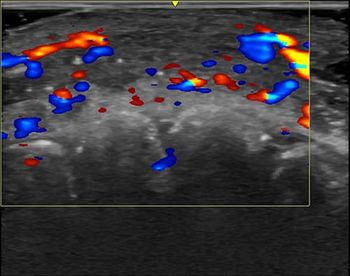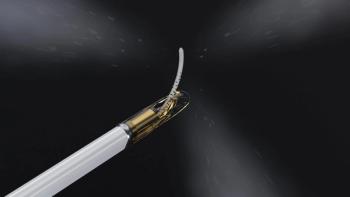
FDA clearances for 2002 reflect R&D moderation since late '90s
Handheld ultrasound product stands outThe number of FDA clearances slipped after a torrid stretch from August to November that salvaged what had been shaping up as one of the worst years for innovation in recent memory. December
Handheld ultrasound product stands out
The number of FDA clearances slipped after a torrid stretch from August to November that salvaged what had been shaping up as one of the worst years for innovation in recent memory. December brought 25 FDA clearances for radiological devices, bumping the total for the year to 295. This was one ahead of the previous year, 12 behind 2000, and 10 ahead of 1999.
Last year reflected a trend in the industry for the past five years-a moderation in R&D that began in the late 1990s. From 1992 to 1995, the industry chalked up well over 300 FDA clearances annually, setting a record in 1995 with 385. Innovation fell dramatically in 1996, as the number of clearances dropped below 300. A spike in 1997 saw that number climb to 348 and then decline again.
From 1998 to 2002, vendors achieved more than 300 clearances only twice, obtaining 311 in 1998 and 307 in 2000. The remaining years ranged from 285 to 295.
While the pace of innovation may have slipped, individual instances of quality advances continue to spring up. A standout in the December 2002 batch was the handcarried "C2" series from SonoSite. The system was described as equivalent to a combination of a SonoSite handheld unit previously cleared by the FDA and the Philips HDI 5000. The highly portable, software-controlled C2 acquires and displays high-resolution, real-time ultrasound in 2D, as well as pulsed wave, continuous wave, color power, velocity color, and directional color power Doppler. The system accepts curved and linear transducers supporting frequencies ranging from 2 to 10 MHz. It has an electrocardiography display feature and supports a three-lead ECG cable to collect data for M-mode measurements.
The DICOM-compliant product supports abdominal, musculoskeletal, small organ, fetal-ob/gyn, cardiac, peripheral vessel, pediatric, neonatal and adult cephalic, intraoperative, transrectal, transvaginal, transurethral, and laparoscopic imaging. Capabilities include cine, zoom, and image labeling, as well as image storage, review, printing, and recording.
Five ultrasound systems, including the C2, were cleared in December. Three were parts of a single submission. The Hudson Diagnostic Imaging 2020, 2040, and 2060 passed FDA review for high-resolution studies of wounds. These include clean, closed surgical incision, skin graft donor site, superficial wounds such as abrasions or blisters, chafed skin, and ulcers. Aloka received clearance to market its general-purpose SSD-3500. The unit, shown as a work-in-progress at the 2002 RSNA meeting, was reviewed with a complement of 28 transducers.
Nine of December's 24 clearances were for image management products. Four of these were display systems from Barco. Most others were workstations or modifications to existing PACS. The one exception was a PACS, called Amalga, submitted by Global Care Solutions based in Bangkok, Thailand.
Remaining products were mostly split between radiotherapy (four) and x-ray (four). Two of the radiotherapy devices were related to brachytherapy; the third was a block of filters; and the fourth displaces the small bowel during therapy.
X-ray products included dual-energy vertebral assessment view software for GE Lunar's Prodigy bone densitometer. Images of the spine produced by the software allow visual identification of vertebral deformations. A product from American Mammographics promises improved patient comfort and better compression of breast tissue. The SOFT (special optimized full-compression tray) paddle allows more breast tissue to be imaged with less compressive force, according to the company.
MR had two clearances, both coils. One, the Champion Peripheral Vascular Coil from USA Instruments, is a multielement phased-array RF coil, designed for use with Hitachi's Altaire 0.7T scanner. The other, a quadrature lower extremity coil by IGC-Medical Advances, is built for GE's Signa 3.0T system to image musculoskeletal, soft-tissue, and vascular structures of the lower extremities.
The sole nuclear medicine product is software designed to reduce Compton scatter. This software, called Photon Energy Recovery (PER), enables scatter correction of single- and multipeak isotope imaging. It also corrects cross-talk scatter in simultaneous multi-isotope imaging. The method, developed by ELGEMS, a sister company of GE Medical Systems, extends features currently on GE's Vision nuclear medicine workstation. Specifically, PER enables gated SPECT acquisition in multienergy window format, which allows normal gated SPECT processing along with PER scanner correction on the summed data.
This latest iteration is based on spectra deconvolution analysis using iterative recurrent linear regressions on nuclear spectra, which are broken into multiple energy windows. (ELGEMS was a joint venture between Elscint and GE Medical Systems until 2001, when GE bought out Elscint's 50% stake.)
Newsletter
Stay at the forefront of radiology with the Diagnostic Imaging newsletter, delivering the latest news, clinical insights, and imaging advancements for today’s radiologists.




























